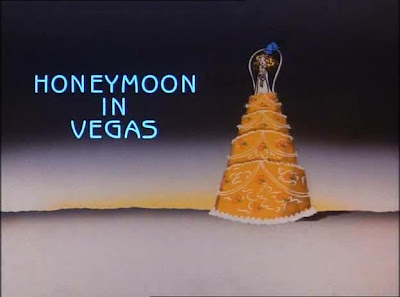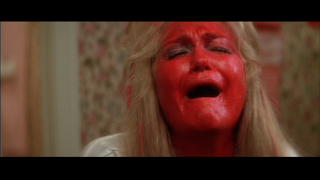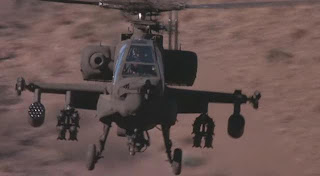As is painfully obvious from the no-posts-in-the-last-two-months status of this little blog, the summer was not kind to the Caged For a Year project.
In fact, it was very nearly mothballed altogether, but that's no way to treat such an ambitious endeavour. After all, what would Cage do? He'd make a scary face and charge headlong once more into the breech!
So here we go. This post is less an informative examination of the movies I've watched at a breakneck pace over the past 10 or so days (and the one or two that I managed to fit in during the Cageless Summer) and more an acknowledgement of my duties and a defiant shout in the face of complacency and giving up on stuff.
So, without further ado, here are the movies I've watched since last I posted. Bear in mind that the first two were watched in August, and all the rest were watched over the course of the last week.
Friday, September 27, 2013
So it's come to this... we close out the '90s with a mashup, catch-up post
Labels:
1990s,
8mm,
Bringing out the Dead,
City of Angels,
Con Air,
Deadfall,
Face/Off,
Guarding Tess,
It Could Happen to You,
Kiss of Death,
Leaving Las Vegas,
Snake Eyes,
The Rock,
Trapped in Paradise
Saturday, July 6, 2013
Red Rock West - mistaken identity strikes again!
In Red Rock West, Cage plays a down-on-his luck former U.S. Marine by the name of Michael Williams. Williams is unemployed, presumably due to some ambiguous-but-undoubtedly-received-in-the-line-of-duty leg injury, but not due to a lack of work ethic or morals, as the film takes pains to demonstrate when he resists the temptation to grab some cash left lying around in an apparently deserted gas station, or to hide his leg issues when applying for a job.
He basically lives in his car, a fact established by the fact that he has an entire "morning-get-ready-for-a-job-interview-to-kick-off-the-movie" scene, all in his car at the side of a lonely Wyoming road.
Williams's moral compass wavers when a bartender assumes that he is "Lyle from Dallas" arriving at his bar for "the job". Assuming (he says) that it's just a regular barroom job, he has a moment of weakness and tells Wayne (the villain of the piece) that he is, indeed, Lyle, and he's here about the job, which turns out to be the murder of Wayne's wife Suzanne.
Wayne, the bartender
Turns out, Suzanne also wants Wayne dead, so she offers Williams even more money to spare her life and take that of her why-is-he-still-her-husband (it's because she's newly rich, by the way), which he accepts, only so far as to take the money and try to leave town, after writing a hastily scrawled note to the local sheriff explaining the convoluted situation.
Anyway, things start to go really "holy-crap-how-can-this-many-terrible-coincidences-happen-to-one-guy" when Williams takes a guy he hits with his car to the hospital, it turns out the guy was shot before he ran into him, and the sheriff is called.
Who is also Wayne.
Wayne, the sheriff
So things continue along those lines, with Williams running into Dennis "Lyle from Dallas" Hopper along the way and all kinds of other crazy shenanigans. The wife, incidentally, is Lara Flynn Boyle, and she's also crazy. The two run off together, and he throws her from a train after a pretty epic graveyard fight scene standoff. Dennis Hopper is a difficult man to kill, as it turns out.
All in all, not a bad movie. I'd watch it, if I hadn't just finished watching it.
Wednesday, June 26, 2013
Amos and Andrew - Like Die Hard with a Vengeance, only not.
So it's been a while, again, but we arrive at the next thrilling installment!
This time it's 1993's Amos and Andrew, a sort of Much Ado About Nothing meets the Keystone Kops meets Die Hard With a Vengeance comedy.
Basically, Samuel L. Jackson plays Andrew Sterling, a well-to-do and reasonably famous black guy whose job it is to be an angry black guy. He's on the cover of Forbes magazine, he teaches at a university and generally gets around on the speaking circuit. He's quite rich.
Sterling has recently moved to an unnamed, upper-class island community in the Northeastern United States. As he's moving his stuff in - in the dark and at night - some nosy neighbours, who are planning on paying a visit to whatever definitively white family used to live in the house, see him moving some stuff around and "naturally" assume that he's burgling the place, so they call the cops.
Incopetent cops, led by a politically ambitious chief, arrive on scene, one thing leads to another, shooting starts happening, and then stuff becomes really big. By that time, the chief has realized that the black guy inside the house and the "hostages" that he's taken are one and the same, and that they're all the famous Andrew Sterling, so he enlists the help of thieving vagabond Amos Odell (played by our hero) to pretend he's taken Sterling hostage, go through the negotiations motions and then be released once everyone's saved face.
It doesn't work out that way, and Amos takes Andrew hostage for real.
Anyway, it's a thoroughly enjoyable movie. The story moves along, one facepalmingly stupid mistake after another, and in the end Amos and Andrew can call each other brother.
That's right. A racially vitriolic Samuel L Jackson learns by the end of the film that the white guy he's been forced to work together with might not be all bad, and may just be an alright guy after all. Remind you of any other movie? That's what I thought.
Thursday, May 30, 2013
Honeymoon in Vegas - A normal Nicolas Cage and an attractive Sarah Jessica Parker... Yeah.
This is getting weird. Honeymoon in Vegas marks two movies in a row that I've actually enjoyed. Not that I haven't already seen some good (and precious few great) movies over the course of this project, but these last two were just simply sit-back-and-watch enjoyable. Zandalee was, obviously, more intense than this, but still...
Anyway, Nicolas Cage plays Jack Singer, a private detective whose mother made him promise, on her deathbed, never to marry. He's a normal guy, with no real accent, regular hair and clothes... It's unnerving almost.
He works at a desk, but not once does he scream his way through the alphabet at a therapist...
Anyway, some years later, his girlfriend is slowly getting tired of his apparently oft-repeated official position on marriage, and they start to drift apart, at which point Singer realizes that if he's going to keep his beautiful, intelligent, sensitive woman in his life, he's going to have to break the promise that he only really made to his mother after she was already dead. Would it even still count at that point? Who knows? So the pair fly to Vegas to get hitched. Oh yeah, and that aforementioned beautiful woman? Played by Sarah Jessica Parker.
This is, believe it or not, the same woman who led Jeremy Clarkson to deploy what is perhaps his greatest simile ever.
Anyway, in Vegas they meet a pro/sleazy/dangerous gambler who takes a fancy to Bessie, and proceeds to arrange things so that he gets to spend the weekend with her.
It's actually a genuinely good movie. It also has Pat Morita in it, playing a Hawaiian taxi driver named Mahi Mahi.
He must've waxed off his facial hair...
The point is, you should go see it. Cage does a good job with his role (he still gets to go a little nuts and have just a bit of screaming, which provides a nice sense of continuity with the rest of his roles) and the whole thing moves along with the kind of predictability and Hollywood rationality that makes for a decent 90 minutes of relaxed movie-watching, as long as you don't take yourself too seriously.
Tuesday, May 28, 2013
Zandalee - finally!
Nicolas Cage only made one movie in 1991, and this was it.
He plays Johnny, a weird (is there any other kind?) painter who lands back in the life of his childhood friend, Thierry (Judge Reinhold), a former poet and professor, current (reluctant) business executive married to the titular Zandalee (Erika Anderson), who is bored and unfulfilled by her bored and unfulfilled husband.
For starters, the movie has more nudity in it than A) most movies, B) any on this list so far, so if that's a deal-breaker for you, move along.
Now that they're gone, I can tell you that I found this to actually be one of the best movies I've seen for this project so far. It's no Raising Arizona, obviously, and the reviewers at IMDB were collectively unimpressed, by the look of it, but I thought that it was compelling. It wasn't just a movie that is watched - it draws you in. There's probably a significant element of "if you let it" involved here - it'd be pretty easy for someone with a hate on for Our Hero to simply dismiss the scenes that he's in (IE most of them) or for someone to dismiss the whole movie as simply smut due to the (many) sex scenes.
All together, though, I thought it was great. I'm glad I watched it, and this is precisely the type of experience that this type of project is awesome for. I never would have heard of this movie otherwise, and now I've seen another film that I really enjoyed. Yay!
That's not to say you don't get to see Crazy Cage in it...
Friday, May 24, 2013
Wild at Heart - David Lynch and Nicolas Cage together again!
Well, what can you say about Wild At Heart?
It's a David Lynch movie. If that last sentence means nothing much to you, I'd recommend starting with Industrial Symphony No. 1, because it's short, and will actually make this look almost reasonable by comparison.
If you're familiar with Lynch, but haven't seen Wild At Heart, then you'll be fine. It's definitely no Eraserhead or Mulholland Dr..
It does contain this shot, and a remarkable fixation on fire, that will offer plenty of reminder that you're watching a David Lynch film...
It's got a fairly contiguous storyline, featuring the ne'er-do-well Sailor (played by Our Hero), his love interest (who spends a seriously large portion of the movie either entirely or partially disrobed, FYI) Lulu (played by Lynch favourite Laura Dern), her legitimately crazy mother and a supporting cast of people, most of whom are trying to kill Sailor. Because Lulu's mom asked/paid them to.
Seriously. Her mom's a crazy person. That's lipstick. Everywhere.
The real story picks up after Sailor gets out of jail, where he did time for beating to death a thug who Lulu's mom hired to kill him, and follows the lovers on their quest to go to California together, despite his parole conditions.
Lulu also brings Sailor his snakeskin jacket. It's a symbol of his individuality and his belief in personal freedom.
Sailor's a weird character, but he manages, in the context of this film's universe, to be fairly normal at the same time, and Cage plays him well, despite the accent.
There are some fairly... vivid... flashbacks as they catch each other up on the weirdness that's made up their lives prior to each other (Lulu's cousin, for instance, was completely nuts, made sandwiches all night and had a cockroach fetish.) that also serve to remind you that your brain and eyeballs are in the hands of the man who made Twin Peaks and Blue Velvet.
This is The Good Witch. This scene is in this movie.
It's a weird movie that swings between surreal ridiculousness to raunchy erotica to really surprising violence to black humour and back again with all the agility of a greased mongoose, but assuming you're cool with all of those things, I'd recommend it. It's an experience, if nothing else - like just about all of Lynch's movies.
Also, Willem Dafoe's in it.
Okay, it was unfair to spring that on you. Here's a shot of how Nic Cage gets out of a car when he's excited about finding some heavy metal on the radio:
You're welcome.
Sunday, April 28, 2013
Fire Birds - Three-peckered goats and eye dominance issues.
As much as our own personal politics may want us to deny it, the following three things are very, very cool:
1) Movies featuring the American Armed Forces.
2) This thing:
3) This guy:
Awesomely, Nicolas Cage's 1990 venture into the military movie genre (no, I'm not counting Birdy as a war movie) Fire Birds is or contains all three of these.
In one shot, no less!
The writing is cheesy, Hollywood-patriot blather at times, and military technobabble at others (yes, I am counting Jones's "You'll be busier than a three-peckered goat" as military technobabble here), but overall quite passable.
Cage plays hotshot helicopter pilot (is there any other kind?) Jake Preston, who is just beginning flight combat training in the Apache helicopter, a training led by Brad Little (Jones), an aging hotshot helicopter pilot (see?) in preparation to take on a malevolent international mercenary hotshot helicopter pilot named Eric Stoller, who has been enlisted by an unnamed drug cartel in a relentlessly unnamed South American county.
Seriously, the number of times that the completely, uselessly nebulous geographical designation "South America" is tossed around in this movie during precise mission orders dialogue is insane.
Near as I can tell, there is no Catamarca Desert (although there is a desert in the Argentinian province of Catamarca, but I guess they relied on the absence of Google to preserve the anonymous nature of the cartel-ridden country in question in the film...)
As is the way with such things, there's a girl involved, who is vaguely established to be a former love interest of Cage, and whose path has brought her back into his life, and there's a personal challenge that helps to bring hotshot pilot A back into the realm of "I'm almost ready to admit that I'm a fallible human being."
The nature of this reality check is interesting - it's basically a problem for Preston that he is left-eye dominant, and the Apache's targeting system (or something) used an eye piece over the pilot's right eye. This causes problems.
I don't know nearly enough about the state of the early '90s American Army vis-a-vis eye dominance to know whether the fact that this problem comes as a complete mystery to Preston, and something that Little doesn't even come up with as a cause for the otherwise nearly flawless pilot's performance (despite having apparently suffered the same thing himself early in his own career) is representative or just a plot device. I sort of hope it's the latter.
Here's how they fix Preston's eye-dominance difficulties:
They wrap women's underwear around his head and give him a rudimentary periscope, and then they have him speed through a busy Army base in a jeep while wearing the get-up. They also (for some reason) spraypaint the windshield of the jeep black, just in case the underpants don't do enough to obscure his vision.
I'd recommend this one for, say, a Sunday afternoon that seems fit for lounging. Like today, for instance. It's an easy movie, the writing flubs and plot holes are pretty easy to overlook as long as you don't take yourself too seriously, and (because I don't believe spoilers are a thing for movies that are 23 years old) the bad guy gets both shot to pieces and blown up in the end, so that's also pretty badass.
Subscribe to:
Posts (Atom)


































